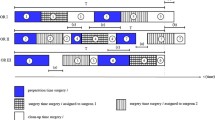Abstract
A surgical scheduling method considering surgeons’ preferences to the time segments has been designed. The one whole day’s work time of an operation room is seen as a kind of resource. According to the number of surgeons who applied for this operation room, the time is divided into corresponding time segments. Time segments and surgeons are seen as two sides of matching problem, the preference functions of two sides have been defined, and the model has been developed based on two-sided matching theory, then the solution of the model has been presented. An example showed that the satisfactions of surgeons have been improved obviously based on the efficient use of time resources.
Similar content being viewed by others
References
Dai J, Xue H (2004) The strategy of profit allocation among partners in dynamic alliance based on the shapley value. Chin J Manage Sci 12:33–36
Deng W, Liu Q, Ren Z, Huang S, Zhang Y (2013) The application of optimal gale-shapley algorithm in students courses selection. J Hunan Univ technol 27:67–70
Echenique F (2008) What matching can be stable: the testable implications of matching theory. Math Oper Res 33:757–768
Fan Z, Chen X (2009) Research on multi-attribute trade matching problem in electronic broker based on axiomatic design. J Manag Sci 22:83–88
Gale D (2001) The two-sided matching problem, origin, development and current issues. Int Game Theory Rev 3:237–252
Gale D, Shapley LS (1962) College admissions and the stability of marriage. Am Math Mon 69:9
Gelain M, Pini MS, Rossi F, Venable KB, Walsh T (2013) Local search approaches in stable matching problems. Algorithms 6:591–617
Jebali A, Alouane ABH, Ladet P (2006) Operating rooms scheduling. Int J Prod Econ 99:52–62
Kinkead, Katharine T (1960) The brightest ever, vol 36. New Yorker, New York
Lamiri M, Xie X, Dolgui A, Grimaud F (2008) A stochastic model for operating room planning with elective and emergency demand for surgery. Eur J Oper Res 185:1026–1037
Li M, Fan Z, Yue Q (2013) Decision analysis method for one-to-many two-sided matching considering stable matching condition. J Syst Eng 28:454–463
Meskens N, Duvivier D, Hanset A (2013) Multi-objective operating room scheduling considering desiderata of the surgical team. Decis Support Syst 55:650–659
Roth A (1986) On the allocation of residents to rural hospitals: a general property of two-sides matching markets. Economics 54:425–427
Teo C, Sethuraman J, Tan W (2001) Gale-shapley stable marriage problem revisited strategic issues and applications. Manag Sci 47:1252–1267
Yang Y, Zhong L, Luo S, Tang G (2013) Comprehensive evaluation of surgical operations based on game theory. J Chongqing Norm Univ (Nat Sci Ed) 30:7–11
Yue Q, Fan Z (2012) Method for two-sided matching decision-making with ordinal numbers. J Syst Eng 27:185–192
Zhan H, Guo J, Zhan H, Yu J (2005) The application of shapley-value in gains distribution of strategic alliance. Commer Res 327:35–37
Zhang H, Yan Z, Fang D (2009) Strategies of profit allocation in enterprisess dynamic alliance value based on shapley applying anp. J Syst Eng 24:205–211
Zhong L, Luo S, Wu L, Xu L, Yang J, Tang G (2014) A two-stage approach for surgical scheduling. J Comb Optim 27:545–556
Acknowledgments
This paper is an achievement of project “Study of the operational mechanism and its optimization of resource management in surgical operations (71371120)” supported by National Natural Science Foundation of China.
Author information
Authors and Affiliations
Corresponding author
Rights and permissions
About this article
Cite this article
Yang, Y., Shen, B., Gao, W. et al. A surgical scheduling method considering surgeons’ preferences. J Comb Optim 30, 1016–1026 (2015). https://doi.org/10.1007/s10878-015-9853-2
Published:
Issue Date:
DOI: https://doi.org/10.1007/s10878-015-9853-2




